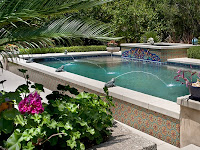When Should I Change my Pool Filter Grids, Cartridges or Sand? Some Key Factors to Look For
One thing that is often overlooked when your pool has a water quality issue is the filtration system. Whether it is cloudy pool water,
algae forming every week or a combination of both, we often treat the symptom
of it and not the cause. The pool’s filtration system is an essential part of
the equation and the age of the filter elements – grids, cartridges, and sand is
sometimes the deciding factor.
When to change your filter grids. Cartridges or sand
can seem like a lot of guesswork. There is no set-in-stone time frame for each
so you will have to do a little detective work to find the correct time.
Obviously, if your D.E. Filter is spitting out D.E. through the return lines it
is time to inspect and probably change the girds. Even a tiny hole in the grids
can shoot back a large amount of dirt, D.E., and debris. Typically D.E. filter
grids are good for 4-5 years, although if your filter gets very dirty and is
under constant high pressure (high PSI on the gauge), then changing them after
2-3 years would not be a bad idea.
Cartridge filters are a bit tougher to diagnose and
you can’t always rely on the filter pressure (PSI). Since the larger 4
cartridge type filters have such a large filtration area the PSI tends to stay
at the clean range for months at a time. If you clean your 4 cartridge type
filter and the PSI is sitting at 20 PSI, don’t be surprised 5 months later even
with very dirty cartridges that the gauge is still reading 20 PSI. For the
single cartridge filters or single bullet filters, as we call them, the PSI will
rise about 10 PSI indicating when the cartridge is dirty.
Typically a 4 cartridge filter will go about 3 years
before you need to replace the cartridges. The only exception to this rule is
the Sta-Rite System 3 Cartridge filter where the large and small cartridge can
go 5 years or more between replacement. The single-cartridge filter should be
replaced every year and sometimes sooner depending if it is on a very large
heavy use pool. The way I gauge a cartridge filter and when it needs new
cartridges is by the flow and water quality of the pool in question. If the
flow is poor after cleaning the cartridge(s) it is probably time to change
them. Again, usage and the size of the pool
are a factor and use the pool’s return flow and water quality as your indicator
– cloudy water or algae, not holding chlorine are some common signs.
For a Sand filter knowing when to change the sand can
be even more difficult. Typically you are using the water quality as your gauge
and also the age of the filter and sand. Of course, if you purchased a house
with an existing sand filter you may not know either so that is not always a
helpful indicator. If you backwash your sand filter and notice the PSI on the
pressure gauge jumps up by 10 PSI after a few days, this may indicate the sand
is no longer working. It could also be the water quality itself causing the PSI
to rise rapidly so you can also do a test using Floc.
If the pool water is very cloudy adding a Floc agent
is a good way to clear I up and test to see if you need new sand. You would add
the Floc agent and run the filter on recirculate for 1 hour. Then turn the pool
pump off for 24 to 48 hours. The Floc agent will drop everything down to the
bottom of the pool and you can then vacuum to waste. If the pool water stays
clear for a few days and the chlorine is holding steady, then your sand is probably
still good. When the water quality turns bad in a sand filter it can affect the
filtration dramatically. That is why the Floc test is a good way to check to see if the sand is good or bad. If you Floc
the pool and then the water clouds up quickly again the filter is probably not
filtering effectively and will need a sand change.
One major way to assess if the filter elements need to
be changed is by the water quality and
the return flow of the pool. If you notice the pool is not holding chlorine and
the water is cloudy I would suggest inspecting and replacing the filter
elements to see if that corrects the problem.
YouTube Video Index: http://poolmandave.blogspot.com/2014/03/swimming-pool-tips-reviews-how-to-video.html – A
list of all of my videos.

Comments
Post a Comment